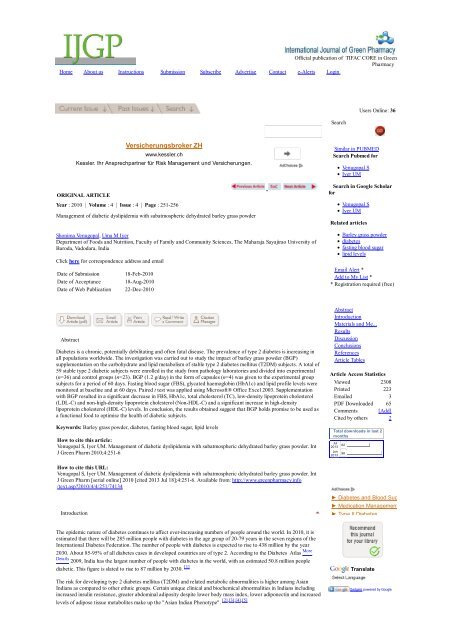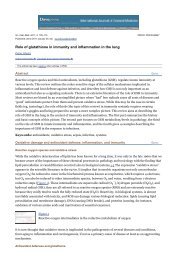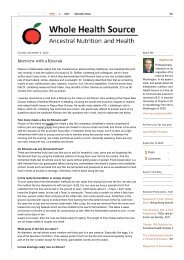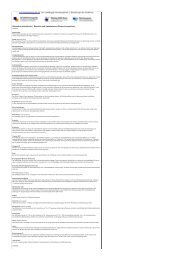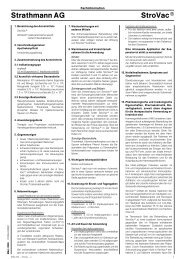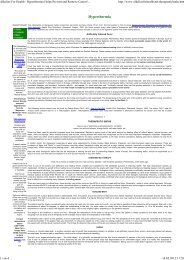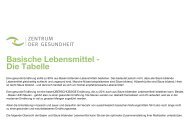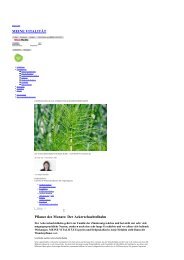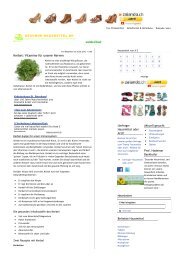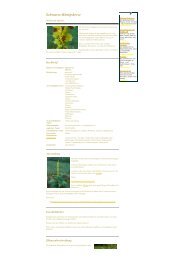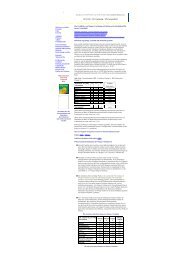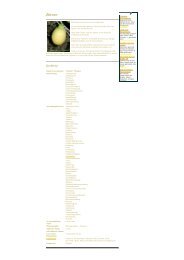Management of diabetic dyslipidemia with subatmospheric ...
Management of diabetic dyslipidemia with subatmospheric ...
Management of diabetic dyslipidemia with subatmospheric ...
Create successful ePaper yourself
Turn your PDF publications into a flip-book with our unique Google optimized e-Paper software.
Official publication <strong>of</strong> TIFAC CORE in Green<br />
Pharmacy<br />
Home About us Instructions Submission Subscribe Advertise Contact e-Alerts Login<br />
Users Online: 36<br />
Share Share Share Share Share Share More<br />
Search<br />
ORIGINAL ARTICLE<br />
Year : 2010 | Volume : 4 | Issue : 4 | Page : 251-256<br />
<strong>Management</strong> <strong>of</strong> <strong>diabetic</strong> <strong>dyslipidemia</strong> <strong>with</strong> <strong>subatmospheric</strong> dehydrated barley grass powder<br />
Shonima Venugopal, Uma M Iyer<br />
Department <strong>of</strong> Foods and Nutrition, Faculty <strong>of</strong> Family and Community Sciences, The Maharaja Sayajirao University <strong>of</strong><br />
Baroda, Vadodara, India<br />
Click here for correspondence address and email<br />
Date <strong>of</strong> Submission<br />
Date <strong>of</strong> Acceptance<br />
Date <strong>of</strong> Web Publication<br />
Versicherungsbroker ZH<br />
18-Feb-2010<br />
18-Aug-2010<br />
22-Dec-2010<br />
www.kessler.ch<br />
Kessler. Ihr Ansprechpartner für Risk <strong>Management</strong> und Versicherungen.<br />
Similar in PUBMED<br />
Search Pubmed for<br />
Venugopal S<br />
Iyer UM<br />
Search in Google Scholar<br />
for<br />
Venugopal S<br />
Iyer UM<br />
Related articles<br />
Barley grass powder<br />
diabetes<br />
fasting blood sugar<br />
lipid levels<br />
Email Alert *<br />
Add to My List *<br />
* Registration required (free)<br />
Abstract<br />
Diabetes is a chronic, potentially debilitating and <strong>of</strong>ten fatal disease. The prevalence <strong>of</strong> type 2 diabetes is increasing in<br />
all populations worldwide. The investigation was carried out to study the impact <strong>of</strong> barley grass powder (BGP)<br />
supplementation on the carbohydrate and lipid metabolism <strong>of</strong> stable type 2 diabetes mellitus (T2DM) subjects. A total <strong>of</strong><br />
59 stable type 2 <strong>diabetic</strong> subjects were enrolled in the study from pathology laboratories and divided into experimental<br />
(n=36) and control groups (n=23). BGP (1.2 g/day) in the form <strong>of</strong> capsules (n=4) was given to the experimental group<br />
subjects for a period <strong>of</strong> 60 days. Fasting blood sugar (FBS), glycated haemoglobin (HbA1c) and lipid pr<strong>of</strong>ile levels were<br />
monitored at baseline and at 60 days. Paired t test was applied using Micros<strong>of</strong>t® Office Excel 2003. Supplementation<br />
<strong>with</strong> BGP resulted in a significant decrease in FBS, HbA1c, total cholesterol (TC), low-density lipoprotein cholesterol<br />
(LDL-C) and non-high-density lipoprotein cholesterol (Non-HDL-C) and a significant increase in high-density<br />
lipoprotein cholesterol (HDL-C) levels. In conclusion, the results obtained suggest that BGP holds promise to be used as<br />
a functional food to optimise the health <strong>of</strong> <strong>diabetic</strong> subjects.<br />
Keywords: Barley grass powder, diabetes, fasting blood sugar, lipid levels<br />
How to cite this article:<br />
Venugopal S, Iyer UM. <strong>Management</strong> <strong>of</strong> <strong>diabetic</strong> <strong>dyslipidemia</strong> <strong>with</strong> <strong>subatmospheric</strong> dehydrated barley grass powder. Int<br />
J Green Pharm 2010;4:251-6<br />
Abstract<br />
Introduction<br />
Materials and Me...<br />
Results<br />
Discussion<br />
Conclusions<br />
References<br />
Article Tables<br />
Article Access Statistics<br />
Viewed 2308<br />
Printed 223<br />
Emailed 3<br />
PDF Downloaded 65<br />
Comments [Add]<br />
Cited by others 2<br />
Total downloads in last 2<br />
months<br />
Jul<br />
2013<br />
Jun<br />
2013<br />
62<br />
98<br />
How to cite this URL:<br />
Venugopal S, Iyer UM. <strong>Management</strong> <strong>of</strong> <strong>diabetic</strong> <strong>dyslipidemia</strong> <strong>with</strong> <strong>subatmospheric</strong> dehydrated barley grass powder. Int<br />
J Green Pharm [serial online] 2010 [cited 2013 Jul 18];4:251-6. Available from: http://www.greenpharmacy.info<br />
/text.asp?2010/4/4/251/74134<br />
Introduction<br />
► Diabetes and Blood Sugar<br />
► Medication <strong>Management</strong><br />
► Type II Diabetes<br />
The epidemic nature <strong>of</strong> diabetes continues to affect ever-increasing numbers <strong>of</strong> people around the world. In 2010, it is<br />
estimated that there will be 285 million people <strong>with</strong> diabetes in the age group <strong>of</strong> 20-79 years in the seven regions <strong>of</strong> the<br />
International Diabetes Federation. The number <strong>of</strong> people <strong>with</strong> diabetes is expected to rise to 438 million by the year<br />
2030. About 85-95% <strong>of</strong> all diabetes cases in developed countries are <strong>of</strong> type 2. According to the Diabetes Atlas More<br />
Details 2009, India has the largest number <strong>of</strong> people <strong>with</strong> diabetes in the world, <strong>with</strong> an estimated 50.8 million people<br />
<strong>diabetic</strong>. This figure is slated to rise to 87 million by 2030. [1]<br />
The risk for developing type 2 diabetes mellitus (T2DM) and related metabolic abnormalities is higher among Asian<br />
Indians as compared to other ethnic groups. Certain unique clinical and biochemical abnormalities in Indians including<br />
increased insulin resistance, greater abdominal adiposity despite lower body mass index, lower adiponectin and increased<br />
levels <strong>of</strong> adipose tissue metabolites make up the "Asian Indian Phenotype". [2],[3],[4],[5]<br />
Translate<br />
Gadgets powered by Google
Traditional medicinal plants <strong>with</strong> various active principles and properties have been used by physicians since ancient<br />
times to treat a great variety <strong>of</strong> human diseases. It has been suggested that compounds present in medicinal plants, either<br />
alone or in combination, possess a variety <strong>of</strong> beneficial activities and have the potential to impart therapeutic effect<br />
holistically in complicated disorders like diabetes and its complications. [6],[7],[8]<br />
Barley grass (Hordeum vulgare) consists <strong>of</strong> young green leaves <strong>of</strong> the barley plant. A wide spectrum <strong>of</strong> vitamins,<br />
minerals, amino acids has been isolated from barley grass. Barley grass contains abundant chlorophyll, antioxidants,<br />
antioxidant enzymes, and other phytochemicals that neutralise free radicals. Many claims have been made regarding the<br />
health benefits <strong>of</strong> barley grass supplements. Some <strong>of</strong> the suggested benefits include prevention and cure <strong>of</strong> cancer,<br />
treatment <strong>of</strong> HIV infection, cholesterol lowering, detoxification <strong>of</strong> pollutants, protection against solar and other forms <strong>of</strong><br />
radiation, and boosting energy and immunity. [9] However, there are a few scientific studies supporting these claims. In<br />
view <strong>of</strong> these observations, the effect <strong>of</strong> barley grass powder (BGP) supplementation on the fasting blood sugar (FBS),<br />
glycated haemoglobin (HbA1c) and lipid pr<strong>of</strong>ile <strong>of</strong> stable T2DM subjects has been focused upon in the present<br />
investigation.<br />
Materials and Methods<br />
Preparation <strong>of</strong> Barley Grass Capsules<br />
Barley grain was procured from the local market and authenticated by botanists from the university. Barley grass was<br />
cultivated on a large scale in a farm. The grass was cut when it was around 10-12 inches in height. The entire lot was<br />
transported to a food industry where it was washed, cut and subjected to cold dehydration (5-10ºC) for 24-30 hours. The<br />
dried product was then ground into a powder form and nitrogen packed. The powder was then filled in capsules in a local<br />
pharmaceutical industry.<br />
Subjects<br />
Fifty-nine stable T2DM subjects who gave verbal consent were enrolled for the study from the pathology laboratories <strong>of</strong><br />
Vadodara. Based on the willingness to consume BGP capsules, they were then divided into two groups, namely,<br />
experimental group and control group. The experimental group consisted <strong>of</strong> 36 <strong>diabetic</strong>s. The experimental group was<br />
given four capsules <strong>of</strong> BGP daily for a period <strong>of</strong> 60 days. Each capsule contained 300 mg <strong>of</strong> BGP, thus amounting to a<br />
total <strong>of</strong> 1.2 g/day. The subjects were asked to take two capsules after lunch and two capsules after dinner. The control<br />
group was given no supplementation. During the course <strong>of</strong> supplementation, no modification in the diet or medication<br />
was made. During the study period, none <strong>of</strong> the subjects took other complementary or alternative medications. The<br />
baseline data were collected on general information, anthropometry, medical history and 24 hour dietary recall along<br />
<strong>with</strong> FBS, lipid pr<strong>of</strong>ile and HbA1c. FBS and lipid pr<strong>of</strong>ile levels were estimated as per standard procedures using<br />
enzymatic kits. HbA1c was estimated using a NycoCard reader. The lipid fractions, low-density lipoprotein cholesterol<br />
(LDL-C), very low-density lipoprotein cholesterol (VLDL-C) and non-high-density lipoprotein cholesterol<br />
(non-HDL-C), were estimated by calculation. All the parameters were monitored at baseline and at 60 days. The study<br />
was approved by the Ethical Committee <strong>of</strong> the Department <strong>of</strong> Foods and Nutrition, The Maharaja Sayajirao University<br />
<strong>of</strong> Baroda, Vadodara, Gujarat, India (Approval No.: FCSC/FND/ME 35; dated: 25/10/2007).<br />
Statistical Analysis<br />
Results are expressed as mean ± SD. The significance <strong>of</strong> the data was evaluated using paired t test. P value <strong>of</strong> an<br />
analysis less than 0.05 was declared to be statistically significant. Confidence interval (CI) limits are specified at 95%.<br />
The statistical analysis was carried out using Micros<strong>of</strong>t® Office Excel 2003.<br />
Results<br />
The mean age <strong>of</strong> the subjects was 58.1±9.0 years in the control group and 56.9 ± 8.0 years in the group supplemented<br />
<strong>with</strong> BGP. The subjects were categorised as overweight and obese on the basis <strong>of</strong> the Asia Pacific Classification [body<br />
mass index (BMI) ≥ 23 overweight and BMI ≥ 25 obese]. A high percentage <strong>of</strong> subjects were found to be overweight<br />
and obese in the control (69.6%) and experimental groups (83.3%). Waist circumference values were found to be higher<br />
than the normal cut-<strong>of</strong>fs (≥90 cm for males and ≥80 cm for females) for both the genders, indicating the presence <strong>of</strong><br />
abdominal obesity. About 43.5% <strong>of</strong> subjects in the control group and 52.8% subjects in the experimental group were<br />
hypertensive.<br />
Impact <strong>of</strong> Barley Grass Powder Supplementation on the Fasting Blood Sugar and Glycated Haemoglobin Levels<br />
<strong>of</strong> Type 2 Diabetes Mellitus Subjects<br />
Supplementation <strong>of</strong> BGP led to a significant fall in the FBS (10.8%) [mean fall = 15.91 mg/dL, CI (0.70-31.12)] and<br />
HbA1c (5.2%) [mean fall = 0.45%, CI (0.21-0.70)] values in the experimental group [Table 1]. Such a change was not<br />
observed in the control group. FBS and its long-term metabolic control were also studied in relation to the initial FBS<br />
values, as initial values are important determinants for the response in supplementation studies. BGP supplementation<br />
led to a significant reduction in the FBS (19.2%) [mean fall = 37.1 mg/dL, CI (8.2-66)] and HbA1c (7.3%) [mean fall =<br />
0.68%, CI (0.25-1.11)] values <strong>of</strong> subjects who had initial FBS greater than 140 mg/dL [Table 2]. In the control group, a<br />
marginal but significant reduction was seen <strong>with</strong> regard to HbA1c levels in subjects having FBS >140 mg/dL (9.4 vs.<br />
9.1%).<br />
Table 1 :Impact <strong>of</strong> BGP supplementation on the FBS and HbA1c levels <strong>of</strong> T2DM<br />
subjects<br />
Click here to view<br />
Table 2 :Impact <strong>of</strong> BGP supplementation on the FBS and HbA1c levels <strong>of</strong> T2DM<br />
subjects based on the initial FBS values<br />
Click here to view<br />
Impact <strong>of</strong> Barley Grass Powder Supplementation on the Lipid Pr<strong>of</strong>ile <strong>of</strong> Type 2 Diabetes Mellitus Subjects<br />
The effect <strong>of</strong> BGP supplementation on the lipid pr<strong>of</strong>ile <strong>of</strong> the experimental and control groups is given in [Table 3]. With<br />
supplementation <strong>of</strong> BGP for a period <strong>of</strong> 2 months, a significant change was observed in the lipid pr<strong>of</strong>ile <strong>of</strong> the <strong>diabetic</strong><br />
subjects. There was a 5.1% decrease in the total cholesterol (TC) values (195 vs. 185 mg/dL) [mean fall = 9.85 mg/dL,
CI (0.96-18.74)]. The atherogenic lipoprotein LDL-C decreased by about 8.2% (122 vs. 112 mg/dL) [mean fall = 9.97<br />
mg/dL, CI (1.05-18.89)]. HDL-C increased by about 5% (40 vs. 42 mg/dL) [mean rise = 2.17 mg/dL, CI (0.62-3.72)]. A<br />
7.7% (155 vs. 143 mg/dL) [mean fall = 12.02 mg/dL, CI (3-21.04)] decrease was found in the non-HDL-C values which<br />
represent a mixture <strong>of</strong> atherogenic lipoproteins. There was a slight nonsignificant reduction in the triglyceride (TG)<br />
values as well. In the control group, the lipid pr<strong>of</strong>ile remained unaltered <strong>with</strong> an exception <strong>of</strong> HDL-C which decreased<br />
significantly. Thus, BGP supplementation brought about significant reductions in TC and its atherogenic lipoproteins.<br />
BGP supplementation also had a significant positive impact on the atherogenic indices, thus lowering the risk <strong>of</strong><br />
coronary heart disease in the <strong>diabetic</strong> subjects.<br />
Table 3 :Impact <strong>of</strong> BGP supplementation on the lipid pr<strong>of</strong>ile <strong>of</strong> T2DM subjects<br />
Click here to view<br />
The lipid pr<strong>of</strong>ile was studied in relation to the initial TC values and is given in [Table 4]. Diabetic subjects who had TC<br />
values ≥200 mg/dL showed a favourable change as compared to those having TC values
In a study on type 2 <strong>diabetic</strong>s, supplementation <strong>with</strong> barley leaf extract (15 g) for 4 weeks reduced the plasma levels <strong>of</strong><br />
TC and LDL-C, increased the vitamin E contents and lag times <strong>of</strong> large, buoyant LDL molecules, and small, dense LDL<br />
molecules, and decreased lucigenin-chemiluminescence and luminol-chemiluminescence levels in blood. The authors<br />
also reported that the response was better <strong>with</strong> barley leaf extract in combination <strong>with</strong> antioxidative vitamins C and E<br />
than barley leaf extract alone. [23] In another study on hyperlipidaemic subjects, supplementation <strong>with</strong> 15 g <strong>of</strong> young<br />
barley leaf extract for 4 weeks substantiated the previous observations. [24]<br />
With a control group, none <strong>of</strong> the subjects being on lipid lowering medication and no significant dietary changes noted<br />
before and after supplementation, our data indicate that improvements in lipids may be due to BGP per se.<br />
In our study, the subjects consumed 1.2 g <strong>of</strong> BGP daily, which is equivalent to approximately 11 g <strong>of</strong> barley grass. Our<br />
study findings add to the scientific basis supporting the cardioprotective role <strong>of</strong> barley leaf extract and/or barley leaves.<br />
Since plant foods are natural sources <strong>of</strong> phytosterols, supplementation <strong>of</strong> concentrated barley grass powder may be a<br />
novel approach to lower cardiovascular risk factors among T2DM subjects.<br />
Conclusions<br />
We feel that BGP has the potential to be marketed as a neutraceutical product to optimise the health <strong>of</strong> <strong>diabetic</strong> subjects.<br />
Advocacy measures to promote barley grass cultivation at household level and to incorporate barley grass in various<br />
recipes can also be attempted as a health promotion strategy. In depth analysis <strong>of</strong> the active ingredients <strong>of</strong> barley grass<br />
needs to be carried out to expand the clinical utility <strong>of</strong> barley grass in other conditions.<br />
References<br />
1. Diabetes Atlas 4 th edition, International Diabetes Federation, 2009. Available from: http://www.diabetesatlas.org<br />
[last accessed on 2010 Feb 3].<br />
2. Mohan V, Sharp PS, Cloke HR, Burrin JM, Schumer B, Kohner EM. Serum immunoreactive insulin responses to a<br />
glucose load in Asian Indian and European type 2 (non-insulin- dependent) <strong>diabetic</strong> patients and control subjects.<br />
Diabetologia 1986;29:235-7.<br />
[PUBMED]<br />
3. Joshi SR. Metabolic syndrome - emerging clusters <strong>of</strong> the Indian phenotype. J Assoc Physicians India<br />
2003;51:445-6.<br />
[PUBMED]<br />
4. Abate N, Chandalia M, Snell PG, Grundy SM. Adipose tissue metabolites and insulin resistance in non<strong>diabetic</strong><br />
Asian Indian men. J Clin Endocrinol Metab 2004;89:2750-5.<br />
[PUBMED] [FULLTEXT]<br />
5. Mohan V, Sandeep S, Deepa R, Shah B, Varghese C. Epidemiology <strong>of</strong> type 2 diabetes: Indian scenario. Indian J<br />
Med Res 2007;125:217-30.<br />
6. Iyer U, Joshi A, Dhruv S. Impact <strong>of</strong> Amla (Embilica Officinalis) supplementation on the glycemic and lipidemic<br />
status <strong>of</strong> type 2 <strong>diabetic</strong> subjects. J Herbal Med Toxicol 2009;3:15-21.<br />
7. Rai V, Iyer U, Mani UV. Effect <strong>of</strong> Tulasi (Ocimum sanctum) leaf powder supplementation on blood sugar levels,<br />
serum lipids and tissue lipids in <strong>diabetic</strong> rats. Plant Foods Hum Nutr 1997;50:9-16.<br />
[PUBMED] [FULLTEXT]<br />
8. Sharma RD, Raghuram TC, Rao NS. Effect <strong>of</strong> fenugreek seeds on blood glucose and serum lipids in type 1<br />
diabetes. Eur J Clin Nutr 1990;44:301-6.<br />
[PUBMED]<br />
9. Barley Grass. Available from: http://www.drugs.com/npp/barley-grass.html [last accessed on 2010 Feb 3].<br />
10. Myint PK, Luben RN, Welch AA, Bingham SA, Wareham NJ, Khaw KT. Plasma vitamin C concentrations predict<br />
risk <strong>of</strong> incident stroke over 10 y in 20649 participants <strong>of</strong> the European Prospective Investigation into Cancer-<br />
Norfolk prospective population study. Am J Clin Nutr 2008;87:64-9.<br />
[PUBMED] [FULLTEXT]<br />
11. Osganian SK, Stampfer MJ, Rimm E, Spiegelman D, Hu FB, Manson JE, et al. Vitamin C and risk <strong>of</strong> coronary<br />
heart disease in women. J Am Coll Cardiol 2003;42:246-52.<br />
[PUBMED] [FULLTEXT]<br />
12. Barley grass: How a plant remedy may <strong>of</strong>fer vital protection against heart disease, stroke and ulcerative colitis.<br />
Available from: http://www.thehealthierlife.co.uk/natural-remedies/herbs/barleygrass-health-benefits-00859.html<br />
[last accessed on 2003].<br />
13. Osakabe N, Yamagishi M, Natsume M, Yasuda A, Osawa T. Ingestion <strong>of</strong> proanthocyanidins derived from cacao<br />
inhibits diabetes-induced cataract formation in rats. Exp Biol Med (Maywood) 2004;229:33-9.<br />
[PUBMED] [FULLTEXT]<br />
14. Lee YA, Cho EJ, Tanaka T, Yokozawa T. Inhibitory activities <strong>of</strong> proanthocyanidins from persimmon against<br />
oxidative stress and digestive enzymes related to diabetes. J Nutr Sci Vitaminol (Tokyo) 2007;53:287-92.<br />
[PUBMED] [FULLTEXT]<br />
15. Das S, Santani DD, Dhalla NS. Experimental evidence for the cardioprotective effects <strong>of</strong> red wine. Exp Clin<br />
Cardiol 2007;12:5-10.<br />
[PUBMED] [FULLTEXT]<br />
16. Markham KR, Mitchell KA. The mis-identification <strong>of</strong> the major antioxidant flavonoids in young barley (Hordeum<br />
vulgare) leaves. Z Naturforsch C 2003;58:53-6.<br />
[PUBMED]<br />
17. Benedet JA, Umeda H, Shibamoto T. Antioxidant activity <strong>of</strong> flavonoids isolated from young green barley leaves<br />
toward biological lipid samples. J Agric Food Chem 2007;55:5499-504.<br />
[PUBMED] [FULLTEXT]<br />
18. Best MM, Duncan CH, Van Loon EJ, Wathen JD. Lowering <strong>of</strong> serum cholesterol by the administration <strong>of</strong> a plant<br />
sterol. Circulation 1954;10:201-6.<br />
[PUBMED] [FULLTEXT]<br />
19. Katan MB, Grundy SM, Jones P, Law M, Miettinen T, Paoletti R. Efficacy and safety <strong>of</strong> plant stanols and sterols<br />
in the management <strong>of</strong> blood cholesterol levels. Mayo Clin Proc 2003; 78:965-78.<br />
20. Sheridan MJ, Cooper JN, Erario M, Cheifetz CE. Pistachio nut consumption and serum lipid levels. J Am Coll Nutr<br />
2007;26:141-8.<br />
[PUBMED] [FULLTEXT]
21. Edwards K, Kwaw I, Matud J, Kurtz I. Effect <strong>of</strong> pistachio nuts on serum lipid levels in patients <strong>with</strong> moderate<br />
hypercholesterolemia. J Am Coll Nutr 1999;18:229-32.<br />
[PUBMED] [FULLTEXT]<br />
22. Yu YM, Wu CH, Tseng YH, Tsai CE, Chang WC. Antioxidative and hypolipidemic effects <strong>of</strong> barley leaf essence<br />
in a rabbit model <strong>of</strong> atherosclerosis. Jpn J Pharmacol 2002;89:142-8.<br />
[PUBMED] [FULLTEXT]<br />
23. Yu YM, Chang WC, Chang CT, Hsieh CL, Tsai CE. Effects <strong>of</strong> young barley leaf extract and antioxidative vitamins<br />
on LDL oxidation and free radical scavenging activities in type 2 diabetes. Diabetes Metab 2002;28:107-14.<br />
[PUBMED] [FULLTEXT]<br />
24. Yu YM, Chang WC, Liu CS, Tsai CM. Effect <strong>of</strong> young barley leaf extract and adlay on plasma lipids and LDL<br />
oxidation in hyperlipidaemic smokers. Biol Pharm Bull 2004;27:802-5.<br />
[PUBMED] [FULLTEXT]<br />
Correspondence Address:<br />
Uma M Iyer<br />
Department <strong>of</strong> Foods and Nutrition, Faculty <strong>of</strong> Family and Community Sciences, The Maharaja Sayajirao University <strong>of</strong><br />
Baroda, Vadodara - 390 002<br />
India<br />
DOI: 10.4103/0973-8258.74134<br />
Tables<br />
[Table 1], [Table 2], [Table 3], [Table 4], [Table 5]<br />
This article has been cited by<br />
1 Authorsæ reply<br />
Venugopal, S., Iyer, U.M.<br />
International Journal <strong>of</strong> Green Pharmacy. 2011; 5(1): 79<br />
[Pubmed]<br />
2 Diabetic dyslipida emia and barley grass powder<br />
Wiwanitkit, V.<br />
International Journal <strong>of</strong> Green Pharmacy. 2011; 5(1): 79<br />
[Pubmed]<br />
Stevia in der Schweiz<br />
www.nu3.ch<br />
Beste Nährst<strong>of</strong>fe günstig bestellen. Top Service & Schnelle Lieferung!<br />
About us | Contact us | Sitemap | Advertise | What's New | Feedback | Copyright and Disclaimer<br />
© 2013 International Journal <strong>of</strong> Green Pharmacy | Hosted and Maintained by Medknow<br />
Online since 15 th February, 2008<br />
www.brncop.org | www.asiapharmaceutics.info | www.aiip.info<br />
ISSN: Print -0973-8258, Online - 1998-4103


